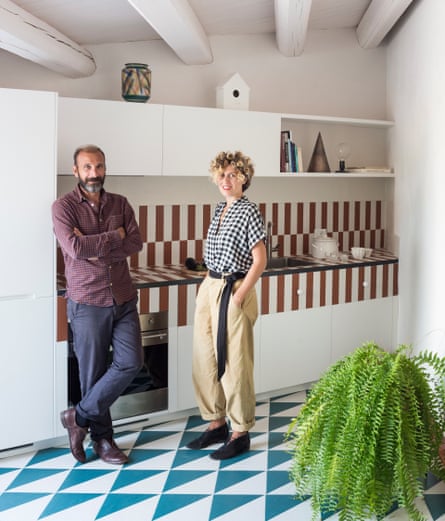
You’ve heard the adage, go bold or go home, but what happens when the two aren’t mutually exclusive? Take the Sicilian home of Ilenia Pappalardo and Nicola Spata in the popular city of Ragusa. A former abandoned cobbler’s shop that the couple bought in 2018 before gutting and completely restoring, it is an ode to vibrant modernism that doesn’t so much put the humble tile into the spotlight, but makes it the all-singing, all-dancing star of the show.
It was a “dream come true” to realise, agree Pappalardo, 37, and Spata, 41, a dental hygienist and an accountant. They enlisted local architects Studio Gum, run by husband-and-wife team Valentina Giampiccolo and Giuseppe Minaldi, to mastermind the restoration.
Their geometry-inspired design uses triangular Pittorica tiles by Studiopepe for Ceramica Bardelli to cover the floors, walls, staircase and terrace in the manner of an interiors Rubik’s Cube. It was like solving “a big puzzle” and one that allowed them to flex their creative muscle.
“Our idea was to create something fresh and young – like them,” says Giampiccolo, who mirrored the shape and coffee-turquoise tones of the tiles in clever corners, feature walls and headboards. The rest of the project demanded a more forensic approach to understanding what the old building, which had been empty for 40 years, would and wouldn’t let them do.
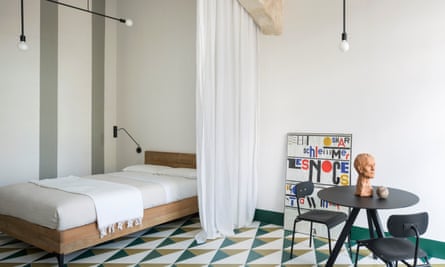
“Old houses are always a discovery,” says Giampiccolo. “When you start breaking the walls down and discover old windows or niches in the roof, you have to evaluate what to change and what to focus on.”
Here, sacrifices were made to flood the once pokey space with lots of light. Old arches were freed from their layers of 1970s cement to be exposed, and new walls were angled to create a play on perspective and proportion throughout the space. The result is that “a damp and dark house has become sunny and warm,” says Pappalardo.
The couple’s big breakthrough came in the attic. “Before we bought the house, I had to make sure the roof terrace was possible,” says Pappalardo. She had fallen in love with the view of Ragusa old town before they found the house. Spata is from Ragusa and the couple made the most of weekend visits back to his hometown when they needed a break from the “more frenetic” Catania – 100km north – where they live during the week. They would wander the streets scouting for potential projects.
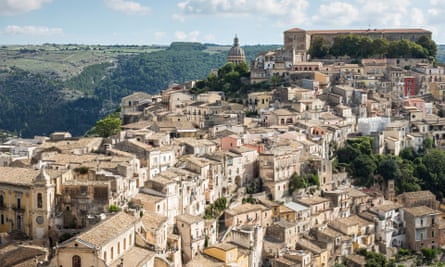
Located halfway between Ragusa Ibla (the old town), a Unesco world heritage site, and the separate, newer Ragusa Superiore, the house was one of a handful of properties to be spared demolition when the winding road was built to join the towns in the mid-19th century. It is perfectly positioned for its inhabitants to admire the beaming baroque skyline of Ragusa Ibla.
“When we viewed the property, I sent Nicola up into the attic and asked him to make a tiny hole in the roof and stick his arm through to take a picture of what could be seen on his phone,” she smiles. “When we looked at the photo, we couldn’t believe it. It was so beautiful.”
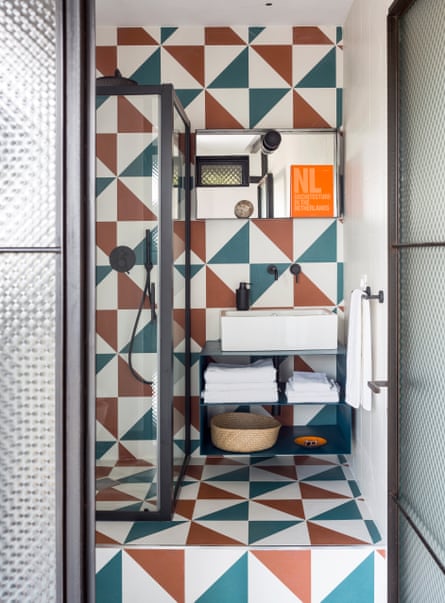
When the project was finally completed in 2021, the terrace became the property’s crowning glory – the couple’s favourite place in which to enjoy aperitivi with friends in the evenings and at weekends, in the “cosy embrace” of Ragusa.
Downstairs is a sparsely furnished space in statement shades that bridges “antique with modern”, says Pappalardo. Lighting by Serax and artworks the couple have picked up on their travels keep it suitably sparse so it can easily be rented out to holidaymakers. “We had an artist guest stay recently who sent me a message to say the light of the house reminded him of a Roberto Rossellini film, and that made me smile.”
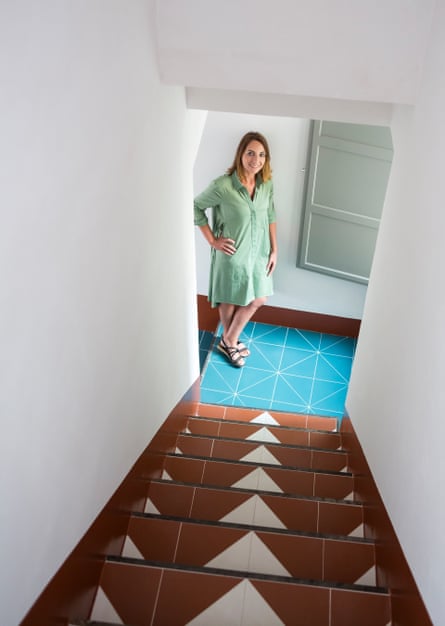
For all its internal drama, you wouldn’t know it to see the house from outside. They decided to leave the exterior of the property unrendered with its original patina to ensure it blends in with surrounding properties and preserves the historic atmosphere.
“Nicola and I think that rather than continuing to build we should re-evaluate and give new life to ancient buildings, to discover their hidden beauties and to return to populating our beautiful Sicilian villages,” says Pappalardo. “We brought an idea of beauty that with Valentina and Giuseppe has become reality.”



